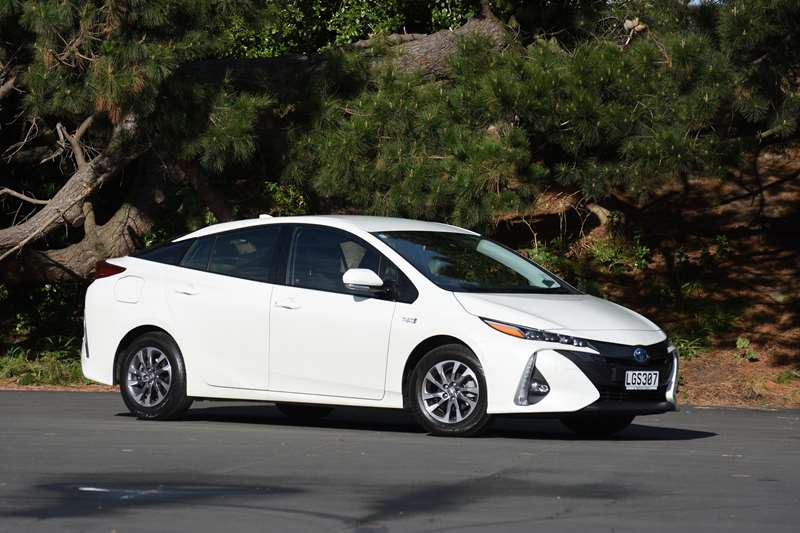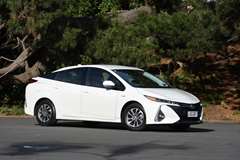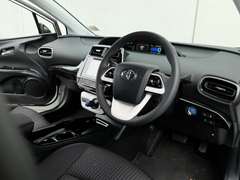| Price: | 48490 |
|---|---|
| Engine: | 1798cc |
| Transmission: | Electronic continuously variable transmission, front-wheel drive |
| Brakes and stability systems: | Front ventilated disc, rear discs, integrated regenerative braking, ABS, BA, EBD, VSC, TC |
| Safety: | Five-star European NCAP |
| Wheels and tyres: | Alloy wheels, 195/65 R15 |
| Fuel and economy: | Premium unleaded petrol, 1.0l/100km, tank capacity 43 litres |
| Emissions: | 22g CO2/km |
| Dimensions: | Length 645, width 1760, height 1470 |

What We Like
- Impressive economy melded with flexibility of use

What We Don't
- Lacks dynamic sparkle
- batteries impinge on luggage space
Verdict
Technically brilliant, this is Toyota's best plug-in hybrid yet
Rating:
Overview
The Prius Prime delivers the best of both worlds, writes David Thomson.
The Toyota Prius hybrid was once the poster child for the electric-car revolution. Now all-electric cars are the big thing, with the Nissan Leaf being top-of-mind for everyday green drivers along with Tesla as the banner bearer for eco-conscious motorists with more to spend.
In comparison to these all-electric machines, the Prius hybrid may seem old hat, but what of its lesser-known close cousin, the Prius Prime?
In electric motoring nomenclature, the Prius Prime is a PHEV, or plug-in hybrid electric vehicle. As such, it combines a conventional engine with a battery-powered electric motor that can be recharged by plugging into the mains.
Available here in only one variant, the Prius Prime is priced at $48,490 _ $2000 more than the top-spec version of the regular Prius hybrid, on which it is based.
As a PHEV, the Prius Prime is designed to deliver the best of two worlds: all-electric zero-carbon motoring for shorter trips with the flexibility of back-up petrol power to free the driver from the range restriction issues that are part-and-parcel of pure-electric vehicles.
Purists may turn up their noses at the PHEV approach because a petrol-electric hybrid delivers low-carbon rather than zero-carbon motoring. But, as Drivesouth's spell with the latest Prius Prime showed, the extent of that carbon reduction can be significant.
The second-generation Prius Prime, as tested, is derived from the fourth generation of the Prius. It deploys a far more powerful 8.8 kWh lithium-ion battery, and a new 68kW dual electric motor system, operated in conjunction with a 1.8 litre Atkinson cycle petrol engine.
Designed for sustained driving on battery power alone, the Prius Prime requires a more powerful, higher-capacity battery than the Prius. To accommodate that larger battery, the car's length has been extended, boot space sacrificed (360 litres) and the spare wheel abandoned (there is an emergency re-inflation kit instead).
The larger battery and plug-in ancillary also add weight, with the Prime being around 130kg heavier than a Prius. This weight gain, incurred despite offsetting features such as an ultra-light carbon fibre reinforced plastic rear hatchback, has forced Toyota to reconfigure the rear of the cabin for two occupants (with a fixed centre armrest) rather than three.
Along with the usual choice of Eco, Normal and Power drive modes, the Prime has several driver-selectable electric/hybrid modes: in EV mode, the car runs on electric power alone for as long as possible; in Hybrid mode, it combines electric and petrol power to what it calculates is the best economy effect; in Charge mode, the petrol engine recharges the battery as well as propelling the car; lastly, there's EV City mode, which is basically a low-power all-electric mode that maximises battery-
only range.
Toyota has sharpened the handling of the regular Prius over the years to the extent that the latest version is a fun to drive. However, with its extra weight, located mostly at the rear, the Prius Prime's dynamics are not of the same standard. The steering, while precise, provides little in the way of feel and hard cornering provokes a fair amount of body roll. The rear suspension is also easily unsettled by surface imperfections, though overall ride quality is good.
On a more positive note, the Prius Prime will accelerate steadily to the legal speed limit and cruise there on battery power alone. Noise levels are low, especially when humming along in a fully-electric mode.
Just how long the Prime will run before the petrol engine comes into play is dependent on several factors, including terrain, speed and traffic volumes.
In driving the test car to-and-from work during the week, charging it at nights, and taking a relatively short out-of-town trip at the weekend, it was possible to cover 40km-45km before the petrol engine or a recharge was required. With a round trip from home to work of roughly 15km, that was ample for all-electric commuting and some errand-running, without the fuss of recharging during the day.
The recharge time for the test car was impressive, too; even when fully drained, the battery returned to full charge in 4-5 hours hooked up to the regular 240-volt home supply.
All-up, I covered just over 160km in the Prime, generally running it in pure electric mode around town, but allowing the car to optimise efficiency by using hybrid mode on the open road.
The petrol gauge barely budged from full, with the total amount of petrol used on test a miserly two litres. That equates to an impressive economy return of 1.25l/100km for a week's driving and a petrol bill of under five dollars. At a rough estimate, electricity recharging costs were about the same again.
On this basis, the Prius Prime PHEV makes a decent case for itself as an environmentally credible alternative to a conventional or non-plug in hybrid car for those engaged in mainly urban driving. The comparison with all-electric alternatives is not as straightforward but if _ as is often the case _ you're an electric car driver who retains a conventionally-powered vehicle for longer trips, then you might consider whether having a PHEV such as the Prius Prime means you could own one car
rather than two.










